Yamaha DKV137138 CompactFlash Wireless LAN Card transmitter for PDA User Manual WL 211F
Yamaha Corporation CompactFlash Wireless LAN Card transmitter for PDA WL 211F
Yamaha >
User Manual
Wireless LAN
Wireless LAN 11Mbps Series
User Manual
Version 1.2.1 – Aug. 2002
User manual Wireless LAN 11 Mbps 1

Wireless LAN
Copyright statement
No part of this publication may be reproduced, stored in a retrieval system, or transmitted in any form
or by any means, whether electronic, mechanical, photocopying, recording, or otherwise without the
prior writing of the publisher.
Printed in Taiwan, May. 2002
User manual Wireless LAN 11 Mbps
2
RADIATION EXPOSURE STATEMENT
The available scientific evidence does not show that any health problems are associated with using low power wireless devices. There is no
proof, however, that these low power wireless devices are absolutely safe. Low power Wireless devices emit low levels of radio frequency
energy (RF) in the microwave range while being used. Whereas high levels of RF can produce health effects (by heating tissue), exposure to
low level RF that does not produce heating effects causes no known adverse health effects. Many studies of low level RF exposures have not
found any biological effects. Some studies have suggested that some biological effects might occur, but such findings have not been confirmed
by additional research. The WD05740 has been tested and found to comply with the Federal Communications Commission (FCC) guidelines on
radio frequency energy (RF) exposures. The maximum SAR levels tested for the WD05740 has been shown to be 0.563W/kg at body.
This device should not be co-located or operated with any other antenna or transmitter.
In addition, use of the equipment other than PDA may not ensure compliance with FCC RF exposure quidlines.
STATEMENTS REGARDING THE WIRELESS LAN CARD
FCC AND INDUSTRY CANADA INFORMATION (U.S.A , CANADA)
FCC WARNING: Changes or modifications not expressly approved by the party responsible for compliance could void the user's authority to
operate the equipment.Properly shielded an grounded cables and connectors must be used for connection to host computer and / or peripherals
in order to meet FCC emission limits.
The installer of this radio equipment must ensure that the antenna is located or pointed such that
it does not emit RF field in excess of Health Canada limits for the general population; consult Safety
Code 6, obtainable from Health Canada's website www.hc-sc.gc.ca/rpb
« L'installateur du présent matériel radio doit s'assurer que l'antenne est située ou pointée
de manière à ce que cette dernière n'émette pas de champs radioélectriques supérieurs aux
limites spécifiées par Santé Canada pour le grand public; consulter le Code de sécurité 6,
disponible sur le site Web de Santé Canada, à l'adresse suivante : www.hc-sc.gc.ca/rpb. »
This device complies with Part 15 of the FCC Rules. Operation is subject to the following two conditions :
(1) this device may not cause harmful interference, and (2) this device must accept any interference received, including interference that may
cause undesired operation.
L'utilisation de ce dispositif est autorisee seulement aux conditions suivantes : (1) il ne
doit pas produire de brouillage et (2) l'utilisateur du dispositif doit etre pret a accepter
tout brouillage radioelectrique recu, meme si ce brouillage est susceptible de
compromettre le fonctionnement du dispositif.
FCC INFORMATION (U.S.A)
1.
2.
3.
IMPORTANT NOTICE: DO NOT MODIFY THIS UNIT!
This product, when installed as indicated in the instructions contained in this manual, meets FCC reqirements. Modifications not expressly
approved by Yamaha may void your authority, granted by the FCC, to use the product.
IMPORTANT: When connecting this product to accessories and/or another product use only high quality shieldedcables. Cable/s supplied
with this product MUST be used. Follow all installation instructions. Failure to follow instructions could void your FCC authorization to use
to use this product in the USA.
NOTE: This product has been tested and found to comply with the requirements listed in FCC Regulations, Part 15 for Class "B" digital
devices. Compliance with these requirements provides a reasonable level of assurance that your use of this product in a residential
enviroment will not result in harmful interference with other electronic devices. This requirement generates/uses radio frequencies and, if not
installed and used according to the instructions found in the users manual, may cause interference harmful to the operation of other electronic
devices. Compliance with FCC regulations does not guarantee that interference will not occur in all installations. If this product is found to be
the source of interference, which can be determined by turning the unit "OFF" and "ON", please try to eliminate the problem by using one of
the following measures:
Relocate rither this product or the device that is being affected by the interference.
Utilize power outlets that are on different branch (circuit breaker or fuse) circuits or install AC line filter/s.
In the case of radio or TV interference, relocate/reorient the antenna. If the antenna lead-in is 300 ohm ribbon lead, change the lead-in to
co-axial type cable.
If these corrective measures do not produce satisfactory results, please contact the local retailer authorized to distribute this type of product. If
you can not locate the appropriate retailer, please contact Yamaha Corporation of America, Electronic Service Division, 6600 Orangethorpe
Ave, Buena Park, CA 90620
Wireless LAN
.Contents
1. Introduction.................................................................................................4
2. Wireless LAN Basics ..................................................................................5
3. Installation for Windows platform................................................................6
3.1. Installation Overview………………………………………………………………...7
3.2. Install Procedure for Windows 98/ME/2000/XP………………………….8
3.3. Win CE 3.0 Install Procedure …………………………………………………………17
4. Configuration Utility...................................................................................22
4.1 Link Status……………………………………………………………………………….23
4.2 Connections……………………………………………………………………………..24
4.3 Profile Setting……………………………………………………………………………25
4.4 About……………………………………………………………………………………..27
5. Troubleshooting ........................................................................................28
User manual Wireless LAN 11 Mbps 3
Wireless LAN
1. Introduction
Thank you for purchasing your Wireless LAN, Wireless LAN 11 Mbps Adapter. This manual will assist
you with the installation procedure.
The package you have received should contain the following items:
• Wireless LAN 11 Mbps Adapter
• User manual
• CD containing Wireless LAN Management utility and drivers
Note: if anything is missing, please contact your vendor
The CD contains drivers and Configuration Utility program that is used for managing the Wireless LAN
Card and establishing the wireless connection with your Local Area Network.
Note: This manual is valid for all Wireless LAN 11 Mbps Series products, such as PC Card, USB,
mini-USB, PCI adapter, mini-PCI, CF card… etc.
User manual Wireless LAN 11 Mbps
4
Wireless LAN
2. Wireless LAN Basics
Wireless LAN (Local Area Networks) systems offer a great number of advantages over a traditional,
wired system. Wireless LANs (WLANs) are more flexible, easier to setup and manage and often more
cost effective than their wired equivalence.
Using radio frequency (RF) technology, WLANs transmit and receive data over the air, minimizing the
need for wired connections. Thus, WLANs combine data connectivity with user mobility, and, through
simplified configuration, enable movable LANs.
With wireless LANs, users can access shared information without looking for a place to plug in and
network managers can set up or augment networks without installing or moving wires. Wireless LANs
offer the following productivity, convenience and cost advantages over traditional wired networks:
• Mobility - Wireless LAN systems can provide LAN users with access to real-time information
anywhere in their organization. This mobility supports productivity and service opportunities not
possible with wired networks.
• Installation Speed and Simplicity - Installing a wireless LAN system can be fast and easy and can
eliminate the need to pull cable through walls and ceilings.
• Installation Flexibility - Wireless technology allows the network to go where wires cannot go.
• Reduced Cost-of-Ownership - While the initial investment required for wireless LAN hardware
might be higher than the cost of wired LAN hardware, overall installation expenses and life-cycle
costs will be significantly lower. Long-term cost benefits are greatest in dynamic environments
requiring frequent moves, adds, and changes.
• Scalability - Wireless LAN systems can be configured in a variety of topologies to meet the needs
of specific applications and installations. Configurations are easily changed and range from peer-
to-peer to full infrastructure networks, also allow roaming over a broad area.
User manual Wireless LAN 11 Mbps 5
Wireless LAN
3. Installation for Windows platform
The following section will assist you to in installing wireless LAN Adapter successfully. You will first
install software (Utility) and then insert / attach the Wireless LAN Adapter to your system, and finally
set the network properties to accommodate resource sharing and select the type of wireless network
that you wish to install. The Wireless LAN card can easily be installed and used, without bothering to
connect cables for keeping your computer to use network resources.
User manual Wireless LAN 11 Mbps
6
Wireless LAN
3.1. Installation Overview
Here are some steps you will perform in establishing your wireless network connection:
Install the Access Point at first. AP is needed in case of Infrastructure network mode.
Install the software using the Install CD.
Install the Wireless LAN Card (WIRELESS LAN 11Mbps Adapter).
Install the network protocol(s) required to communicate on your network. Most likely you will need
the TCP/IP protocol.
User manual Wireless LAN 11 Mbps 7
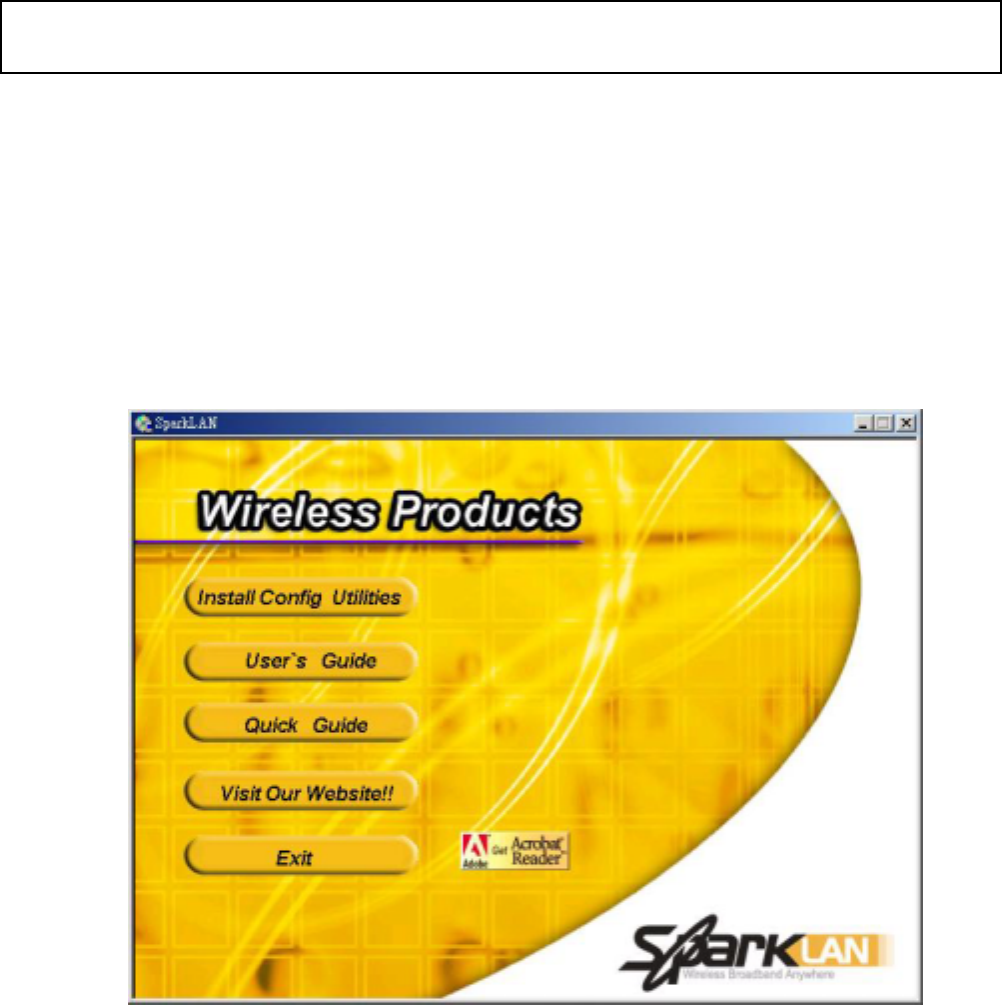
Wireless LAN
3.2. Install Procedure for Windows 98/ME/2000/XP
Note: Do not insert the WLAN Adapte
r
until you are asked to do so, failure of which may result in unsuccessful
installation of your WLAN device.
Please follow the following steps one by one in order to install the WLAN
Adapter successfully.
Note: Install WLAN CF card on your laptop PC must add additional PCMCIA adapter.
1. Power on your computer and allow Windows 98/ME/2000/XP to load fully.
2. Be sure that there is no Wireless LAN 11Mbps Adapter inserted yet.
3. Insert the given Installation CD in the CD-ROM .You will see below. If you did not see it. Please go
to CD folder. Click autorun.exe file.
User manual Wireless LAN 11 Mbps
8
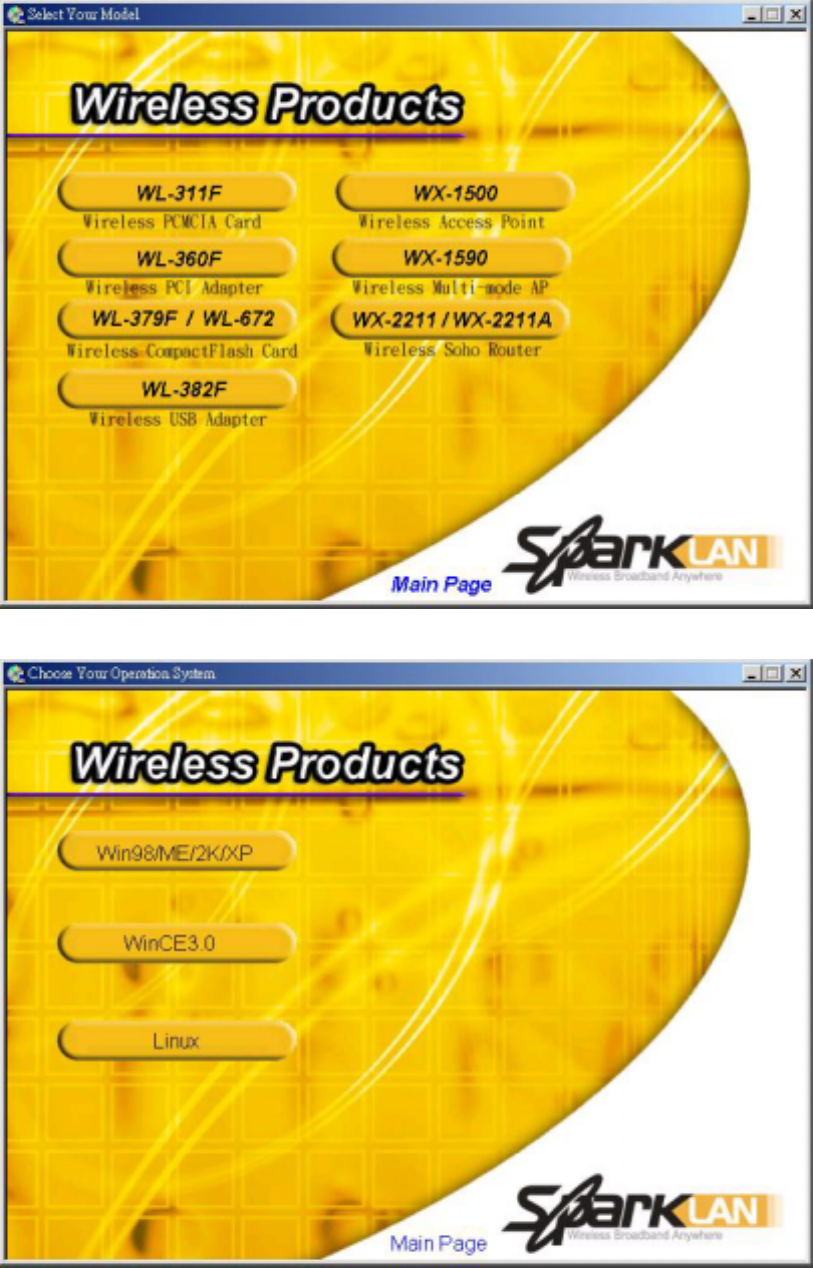
Wireless LAN
4.Select your model.
5.Choose Your Operation System.
User manual Wireless LAN 11 Mbps 9
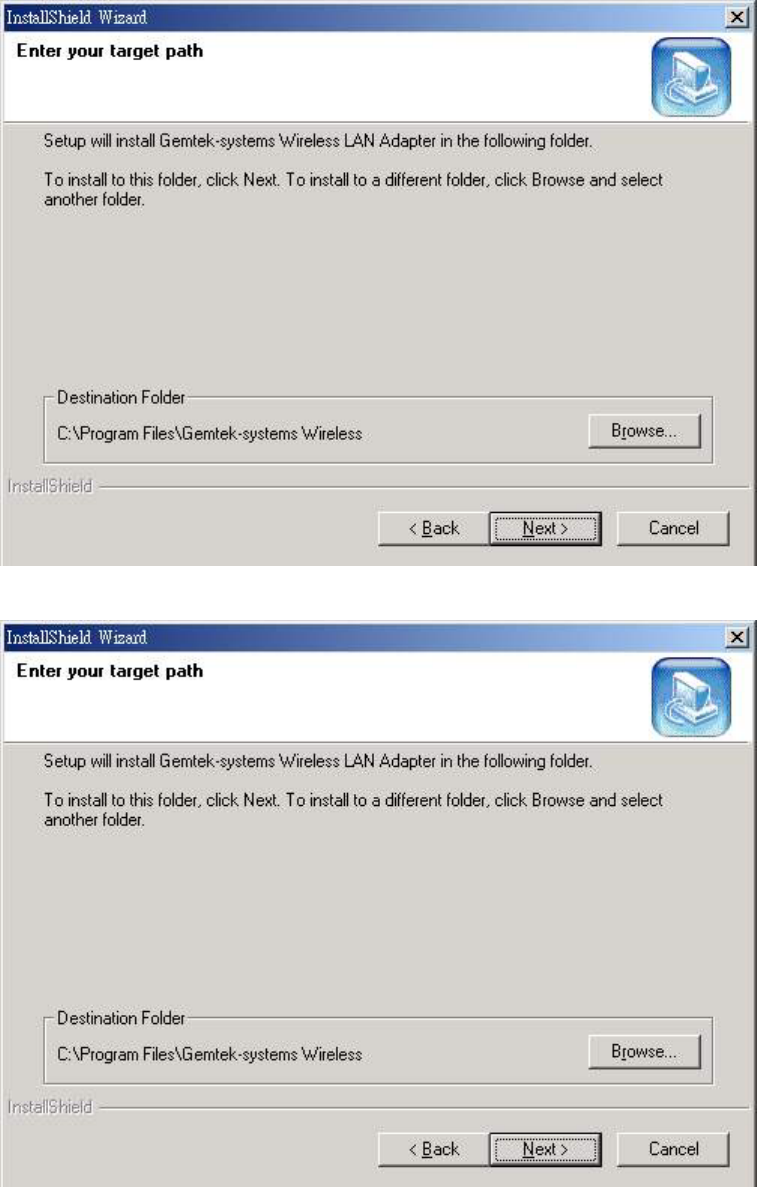
Wireless LAN
6.When you click win98/ME/2000/XP you will see below
At the “ Enter your target path ” window, click Next.
User manual Wireless LAN 11 Mbps
10
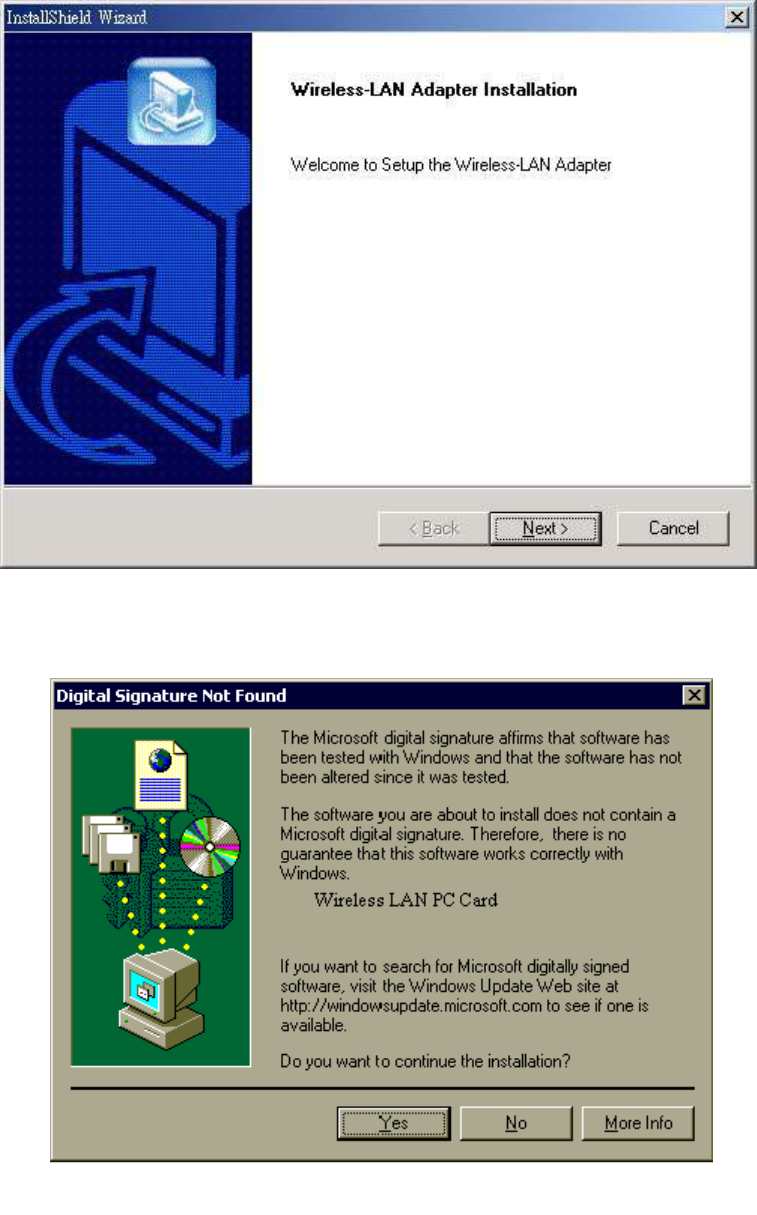
Wireless LAN
Click Yes
User manual Wireless LAN 11 Mbps 11
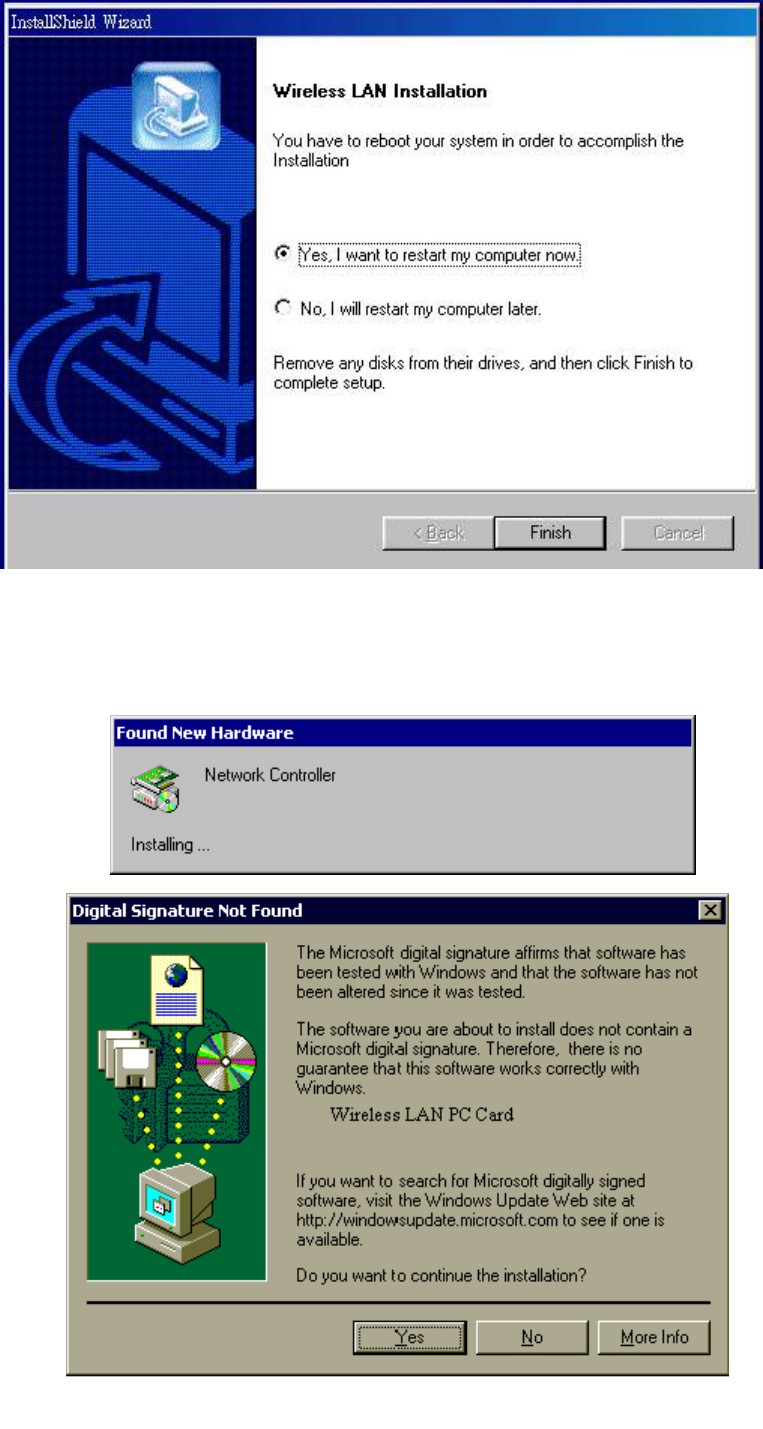
Wireless LAN
4. Insert / attach Wireless LAN 11 Mbps Adapter to your system
Windows will recognize the WLAN adapter and auto detect the driver, if the system did not find the
driver automatically, please install the driver manually.
.
Click Yes to finish the installation.
User manual Wireless LAN 11 Mbps
12
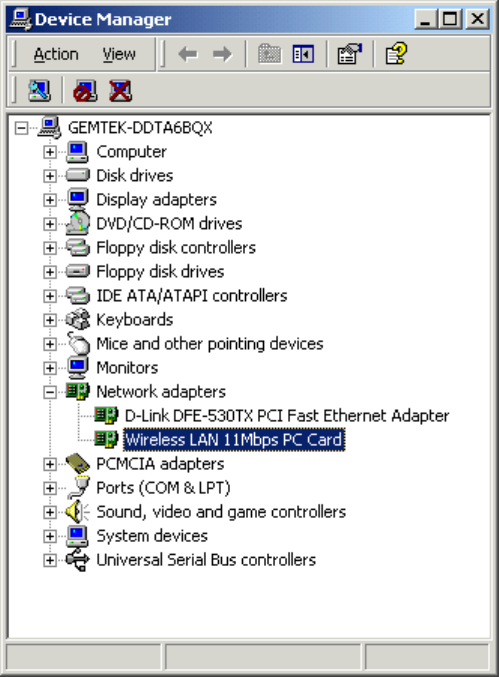
Wireless LAN
5. Click the right button of mouse on My Computer Properties Device Manager.
Check whether it has WLAN adapter in one of the sockets or not. If you find Wireless LAN
11Mbps Adapter in one of the sockets, it means the card is detected properly.
6. Click right button of mouse on the Network Neighborhood .
7. Select Properties from the pop up menu. The network box appears and you see three main tables:
Configuration, Identification, and Access Control.
User manual Wireless LAN 11 Mbps 13
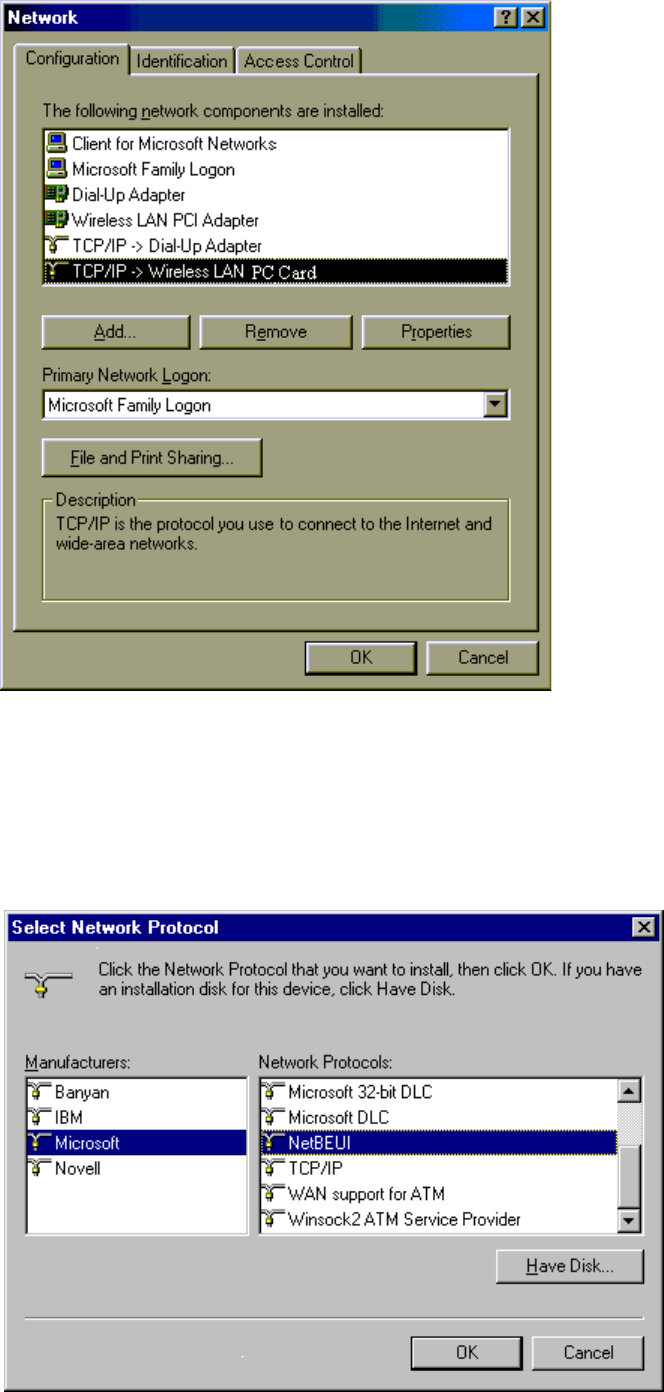
Wireless LAN
8. Click on the Configuration tab and then click on the Add button. Select Network Component Type
box appears. Click on the Protocol the click the Add button.
9. Select Network Protocols box appears. From the list of manufactures, click on Microsoft. From the
list of network protocols list, select NetBEUI, then click OK.
10. The NetBEUI protocol is now installed. After clicking on OK return back to Network Component
Type box.
User manual Wireless LAN 11 Mbps
14
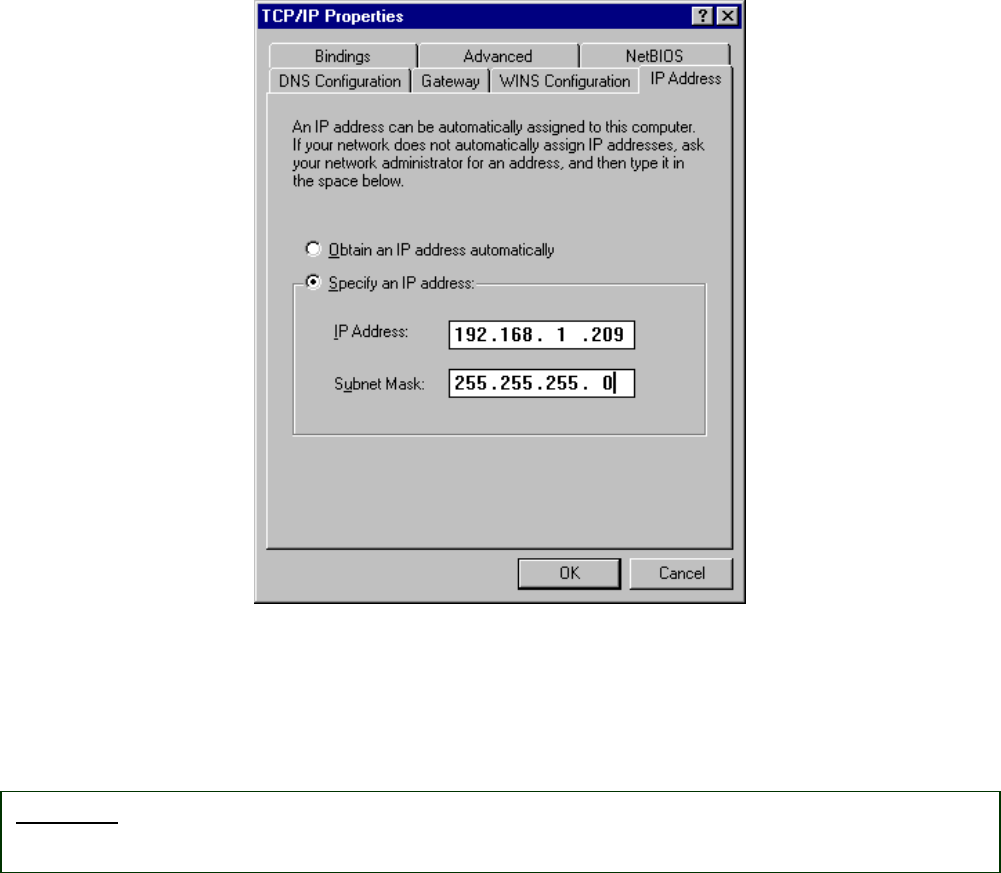
Wireless LAN
11. Repeat the step 15 and 16 to add IPX/SPX protocol.
12. Repeat the step 15 and 16 to add TCP/IP protocol.
13. Click on the TCP/IP option for setting the IP address for your computer. You can select either Static
or DHCP setting. If you use the static IP setup then enter the IP value, Subnet masking, DNS,
Domain/ Workgroup name, and Gateway Address values. After setting these parameters
appropriately, click OK to return to Network Component Type and you can select the File and
Printer Sharing options as well as the Access to your computer like other users connected to that
network by setting the computer sharing options. Click on OK.
14. Screen message do want to restart your Computer will pop up. Select Yes. It will shut down your
computer and restart.
Important: Restart your computer to make the changes effective before you reinstall the
driver.
User manual Wireless LAN 11 Mbps 15
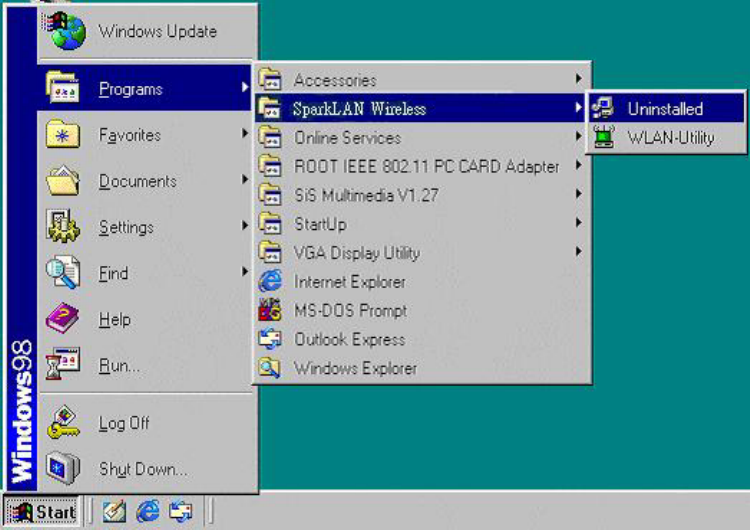
Wireless LAN
Uninstall Procedure
Step 1:
If you want to uninstall the WLAN adapter, just simply click
Start Menu Program File SparkLAN Wireless Uninstalled, it shall uninstall all related
programs.
Step 2:
Restart your Computer.
User manual Wireless LAN 11 Mbps
16
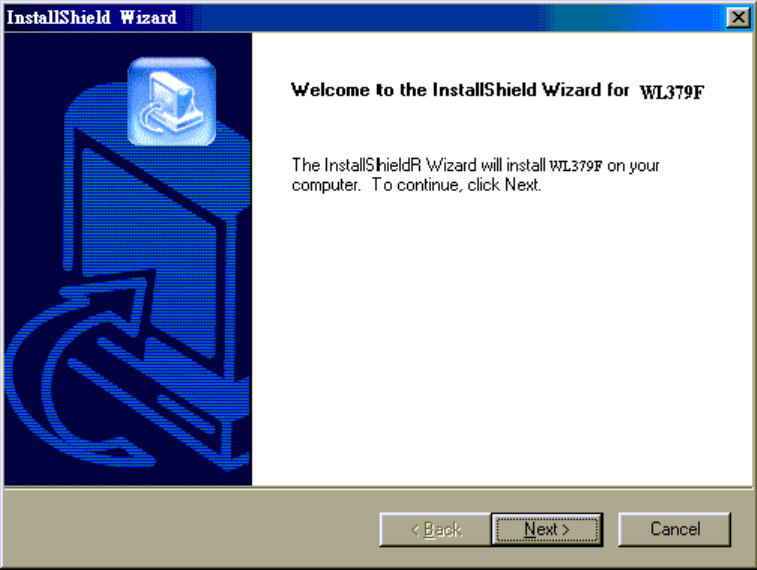
Wireless LAN
3.3. Win CE 3.0 Install Procedure
Please be note that the current version of driver only supports Strong ARM processor.
Note: Be sure that your PC or Notebook has installed software such as Active Sync for transmit data
to your PDA / handhold PC.
We assume that you have installed Windows CE Services on your desktop PC and that you have
connected the PC to PDA or handheld PC with a serial connection.
Note: The CF/PC card shall not be plugged into PDA/handheld PC if not stated.
1) Run the GTK30Setup.exe from the CD. This will bring up installation screen:
If you would continue go through the process by pressing “Next” button, otherwise select “Cancel” if
you wish to stop the installation process.
User manual Wireless LAN 11 Mbps 17
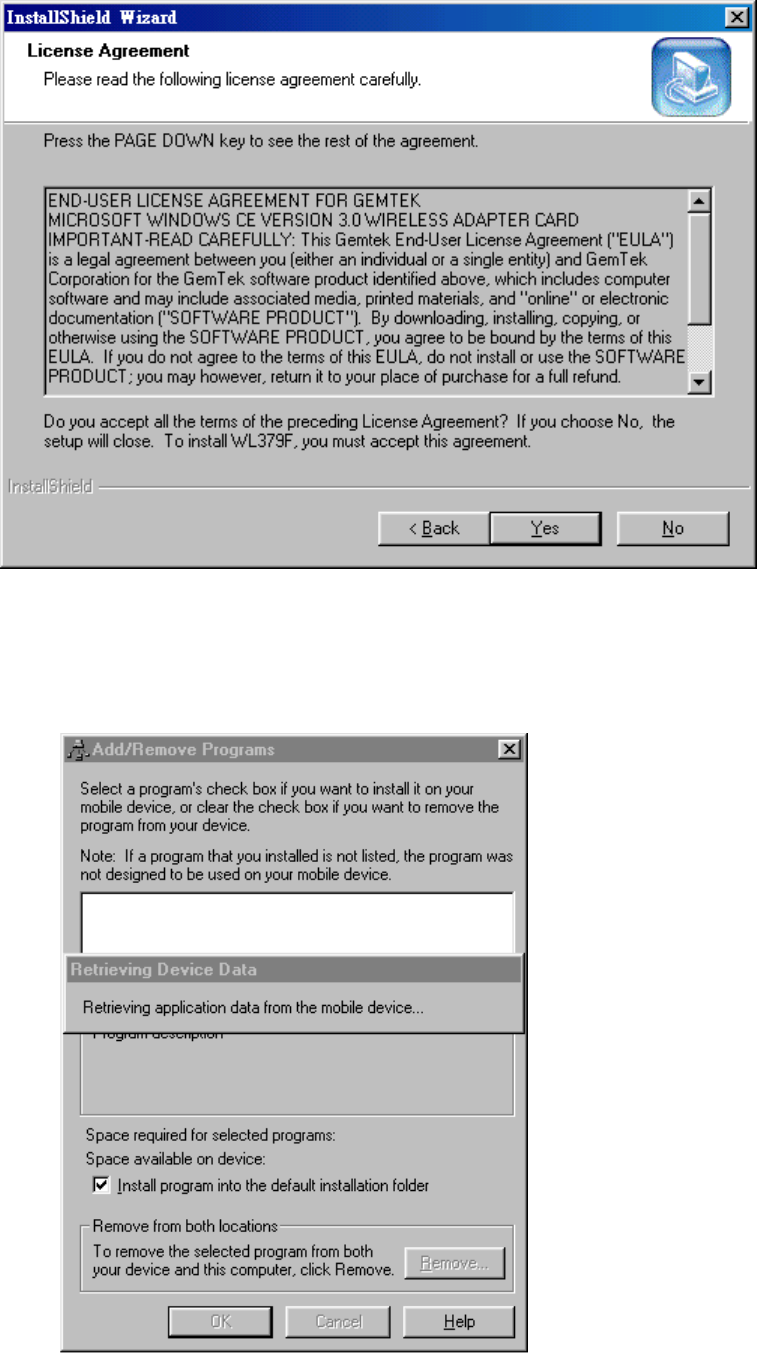
Wireless LAN
Accept license agreement by click “Yes” button. If you disagree with terms of stated, then press “No” &
exit the installation.
When software license agreement is accepted, system will bring you user info dialog.
User manual Wireless LAN 11 Mbps
18
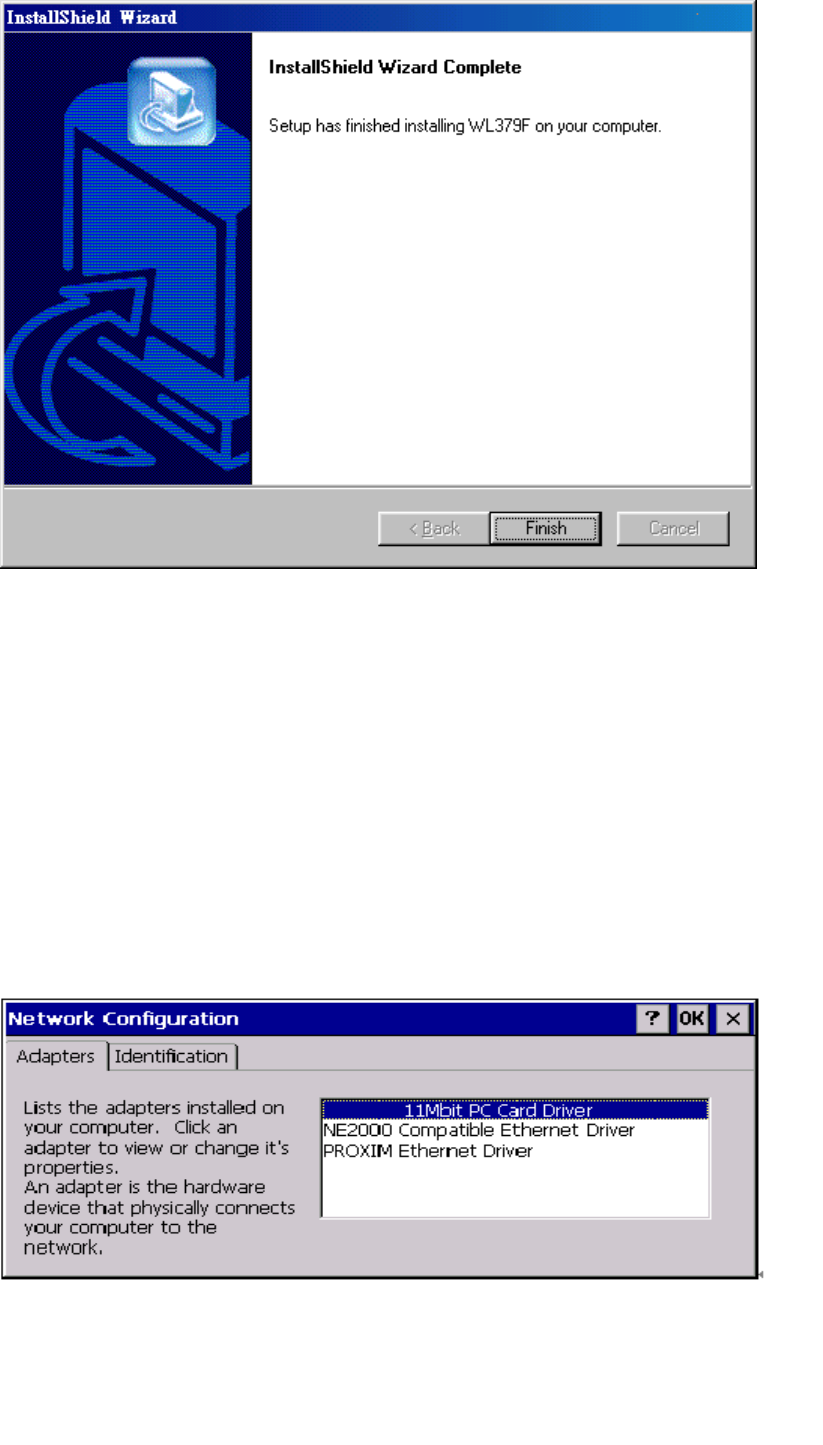
Wireless LAN
Click Finish to complete the installation.
2) Plug-in the Wireless LAN CF/PC card into the card slot of your PDA/handhold PC
.
3) Go to the Start menu, select Settings subfolder. Then select Connections tab from the bottom of
the page.
4) In the Setting page, tap on Network icon. This step will open Network Connections dialog
User manual Wireless LAN 11 Mbps 19
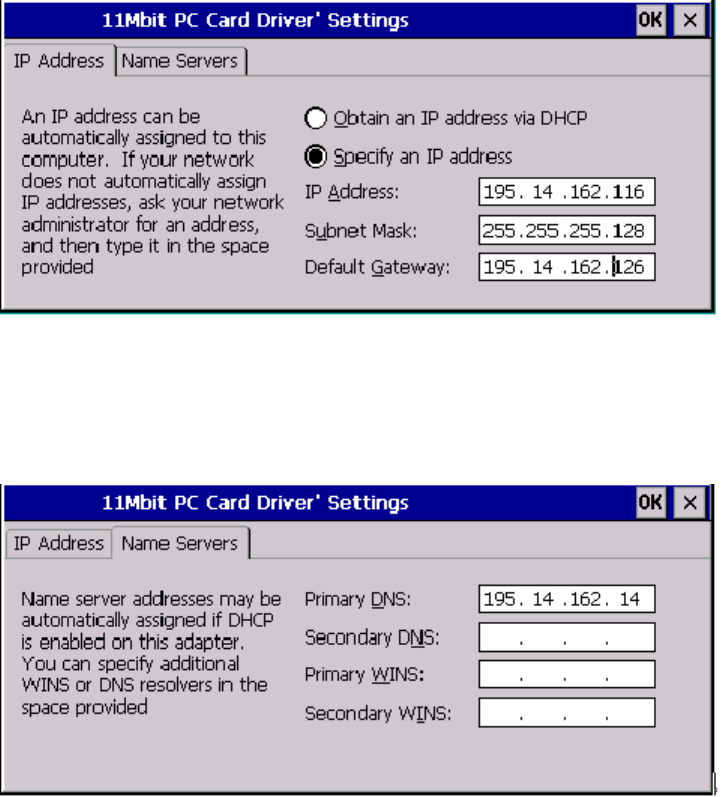
Wireless LAN
On the Network Configuration dialog select 11Mbit PC Card Driver and double tap on it, this
will bring you to IP Settings dialog.
5) If your network supports DHCP server, select the first button. Otherwise enter static IP in the field. If
you are not sure about the values of these fields, ask your Internet Service Provider for detail.
6) Select “Name Servers” page for DNS settings.
Enter Domain Name Server (DNS) address & WINS (sometimes it is assigned through DHCP
services automatically) in appropriate tab.
NOTE: If Domain Name Server address does not input in the field, networking using Explorer will not
work EVEN if enter IP addresses. This is due to internal Windows CE architecture.
User manual Wireless LAN 11 Mbps
20
Wireless LAN
Win CE uninstall procedure
Tap on the Start Menu, select Settings tab. Tap on System tab from the bottom of the page, Tap on
the on the Remove Programs. Select WL-379F and tap on the Remove button will uninstall the
program.
User manual Wireless LAN 11 Mbps 21
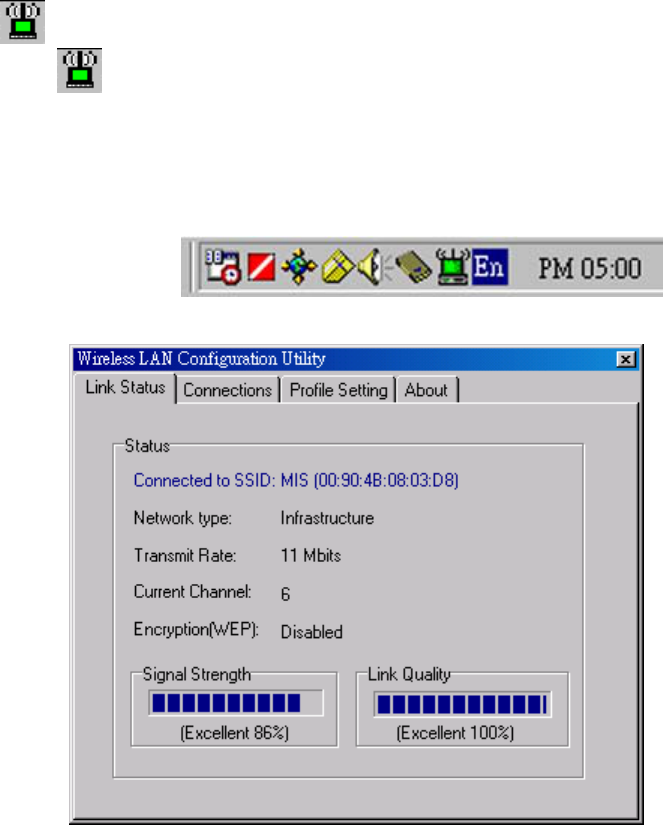
Wireless LAN
4. Configuration Utility
Wireless LAN 11 Mbps Wireless LAN adapter uses its own management software. All functions
controlled by user are provided by this application. Usually this application starts
automatically,
or click icon from Start Menu to start the Utility application.
A new icon - should appear in your Icon tray. If the icon is in red, it means that Wireless
LAN 11 Mbps NIC configuration is invalid or incomplete. Sometimes icon can be colored in red.
This may happen when communication is defined poor connection or incorrectly.
Figure 1 Icon tray with a new icon
User can navigate through “sheets”, by clicking tabs. “X” button will minimize window.
Below description explains the use and meanings of the various screen messages.
User manual Wireless LAN 11 Mbps
22
Wireless LAN
4.1 Link Status
- Status
This field is used to display the current status of connection. When the state shows “Connected to
SSID“means normal flow of operation in Infrastructure mode. The PC is connected to access
point. Networking is available.
A state of “Scanning” means that the node is searching for available access point and unable
detects the SSID for an available access point within range.
This field will also display an error message for some reason if the driver failed to initialize.
Network Type
Infrastructure Mode - The driver will scan all available channels continuously until it finds one or
more Access Points that matches its SSID. At that point it will try and authenticate and
associate with the Access Point.
Ad Hoc Mode - The driver will scan for 5 seconds looking for an existing Ad Hoc network
using the same SSID.
- Current Channel and Transmit Rate
Shows the channel of the radio and transmit rate are being currently used for an active connection.
This value has no meaning when the radio is “Scanning”
- Link Quality
The Link Quality bar graph is only active when the node is in Infrastructure Mode. The bar graph
displays the quality of the link between the node and Access Point. It summarizes the quality of
the link over the bar graph, which can take on one of the following values:
“Poor”
“Fair”
“Good”
“Very Good”
“Excellent”
- Signal Strength
The Signal Strength bar graph is only active when the node is in Infrastructure Mode. The bar
graph displays normalized signal strength as reported by the radio, averaged over all frames over
100 bytes long that are received from the Access Point.
User manual Wireless LAN 11 Mbps 23
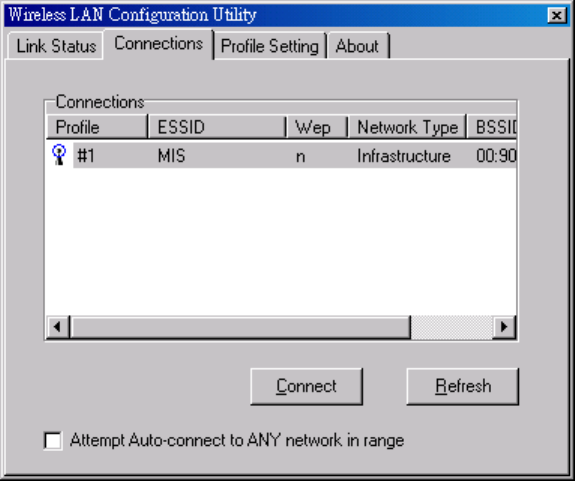
Wireless LAN
4.2 Connections
The Connections Tab shows current status of available APs within the
network.
User may select profile or ESSID from above list, click “Connect” to connect with the AP.
Click “Refresh” to rescan the network, this utility with site survey function, it will detect and list all
available APs within network.
Place a check mark in the field if you wish attempt Auto-connect to ANY network in the range.
.
User manual Wireless LAN 11 Mbps
24
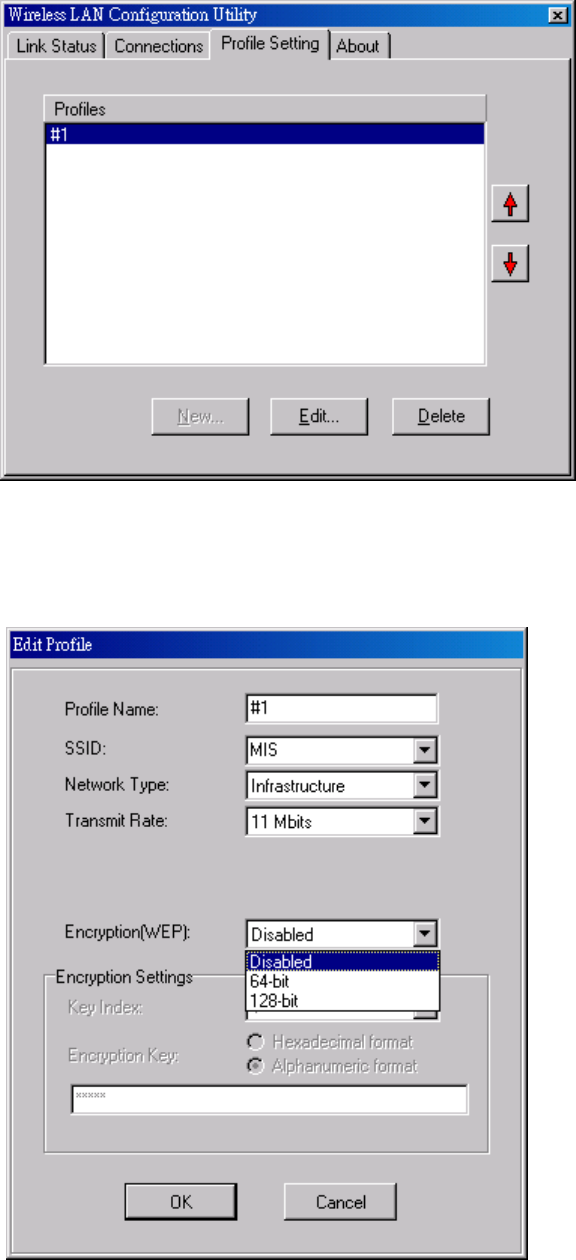
Wireless LAN
4.3 Profile Setting
Profile Setting allow user to create profiles for different network environments.
Click “New” button to create new profiles.
“Edit” for edit current exist profile.
Click “Delete” button if you wish to delete profiles.
User manual Wireless LAN 11 Mbps 25
Wireless LAN
- Network Type
This field allows you to select from a list of supported Network “Modes”. The modes displayed will
have two values: “Ad Hoc” and “Infrastructure”.
Ad Hoc - This is the 802.11 peer-to-peer mode of operation. In 802.11Ad Hoc only one wireless
“cell” is supported for each different SSID. All communication is done from Client to Client without
the use of an Access Point. 802.11 Ad Hoc networking uses the same SSID for establishing the
wireless connection.
Infrastructure - This mode of operation requires the presence of an 802.11 Access Point. All
communication is done via the Access Point, which relays packets to other wireless Clients in
the BSS as well as to nodes on a wired network such as Ethernet.
Transmit Rate – The transmission rate at which client of AP transmits the data packets. You may
set this to fixed 1Mbps, fixed 2 Mbps, fixed 5.5 Mbps or 11 Mbps.
Encryption (WEP) - You may desire an additional measure of security on your wireless network,
which can be achieved by using WEP (Wired Equivalent Privacy) encryption.
When an encrypted frame is received it will only be accepted if it decrypts correctly. This will only
happen if the receiver has the WEP Key used by the transmitter.
This panel allows to entry for 64/128-bit encryption according to WEP function select. To be
written to the driver and registry, such as Hexadecimal format, each key must consist of hex digits,
which means that only digit 0-9 and letters A-F are valid entries. If entered incorrectly program will
not write keys to a driver.
.
User manual Wireless LAN 11 Mbps
26
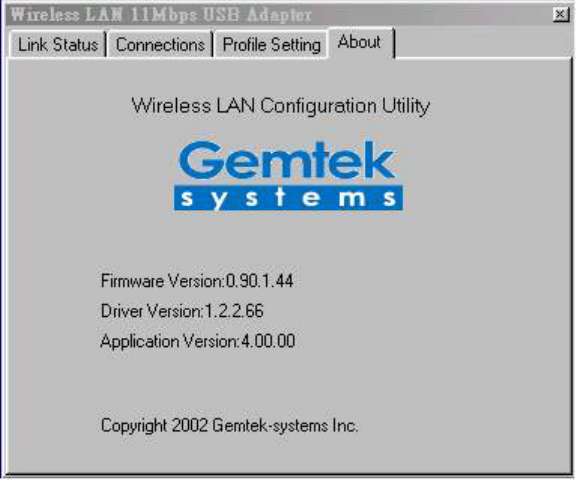
Wireless LAN
4.4 About
About tab shows the product version including the detail of Driver, Application and firmware
version. Users must use this version number when reporting their problems to technical
support.
User manual Wireless LAN 11 Mbps 27

Wireless LAN
User manual Wireless LAN 11 Mbps
28
5. Troubleshooting
If you encounter any problems during the installation, or to confirm that the WLAN 11Mbps device is
installed properly, please read the following troubleshooting section.
In Windows 98:
To check that the WLAN 11Mbps device is installed properly, please do the following:
1. Go to START>SETTINGS>CONTROL PANEL>NETWORK. Choose the Configuration Tab. If you
find the WLAN 11Mbps Adapter, it means the card is installed properly. If you see the Yellow
Question-mark (?) means the resources are conflicting. (Please read further in this section for
solutions.) -or-
2. Right click on My Computer and select Properties. Select the Device Manager and click on the
Network Adapter. You will find the WLAN 11Mbps Adapter if it is installed successfully. If you see the
Yellow sign, the resources are conflicting. Click on the PCMCIA Card and then on the PCMCIA Card
Service, you can see the status of the PC card. If there is a yellow sign either on the adapter or the PC
card, please check the following.
1. Check to see if your computer supports 3.3V Card.
2. Check to see if your computer has a free IRQ. If not, make an IRQ free by assigning the
same IRQ to some devices, for example COM 1; COM 2 can be assigned the same IRQ
values.
3. Check that you have inserted the right card and have installed the proper driver.
Troubleshooting (Continued)
In Windows 2000:
1. Check the Windows 2000 Diagnostics. See if there is any conflict in the resource allocation or
the I/O Address, IRQ allocations. If you find that the IRQ or I/O Addresses are already assigned
to some other devices, you must change that value. I/O Address needs 40h byte length.
2. Go to the Control panel. Double click on the PCMCIA Card and you will see WLAN Adapter.
Double clicking on that will show you the Card Information, driver name and the driver file. You
must confirm the name of the driver and the driver file as "prismnic.inf" and "prismnds.sys". If
you do not find the names listed above, there are some problems and the driver is not installed
properly. Reinstall the driver.
Note: Check the PnP BIOS setup menu and select no in case of the WLAN Adapter installation.